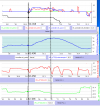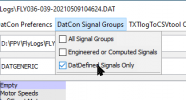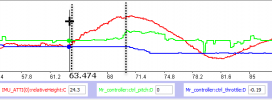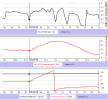When turning my FPV will often gain altitude. I was assuming that it is because I inadvertently was moving the throttle while giving it yaw input. But, that doesn't appear to be the case. I'm hoping someone can tell me what I'm doing wrong.
Below are plots that illustrate this with the turn taking place between the two dashed lines.

The top plot shows the stick inputs. Note the pitch and throttle are held constant while the roll and yaw are given positive input.
The second plot shows the altitude gain of about 30 meters.
The third plot shows the roll dipping for about 0.75 secs and then slowly rising in the turn. In the last plot the pitch rises at first but then starts to decrease.
@Kilrah
Below are plots that illustrate this with the turn taking place between the two dashed lines.

The top plot shows the stick inputs. Note the pitch and throttle are held constant while the roll and yaw are given positive input.
The second plot shows the altitude gain of about 30 meters.
The third plot shows the roll dipping for about 0.75 secs and then slowly rising in the turn. In the last plot the pitch rises at first but then starts to decrease.
@Kilrah



